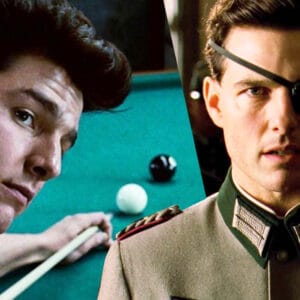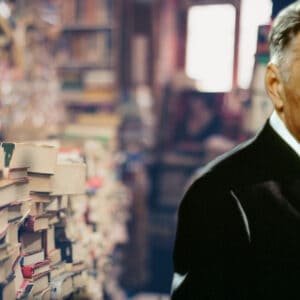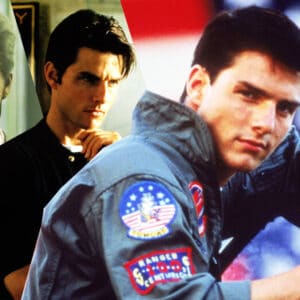There are stories of coincidence and chance, of intersections and strange things told, and which is which and who only knows? And we generally say, ‘Well, if that was in a movie, I wouldn’t believe it.’ Well, believe it, because all of what follows actually happened during the making of Paul Thomas Anderson’s 1999 film Magnolia.
A film and production of gambles, absurdities, forgiveness, and reckonings, Magnolia evolved from what would be the final shot of the film – a smile, a symbol of hope in a world of misery, lost drive and…frogs – into one of the most divisive, memorable and best films of the century.
So, let’s get our buzzers ready and wise up as we find out: What happened to this movie?!
Magnolia has its origins in the post-production of Boogie Nights, with Paul Thomas Anderson looking into going down to the “intimate and small scale” of his 1996 debut, Hard Eight, as tackling another ensemble epic just seemed too daunting. And it all began with a smile…
The first thing PTA kept picturing was what ended up being the final shot: Melora Walters’ Claudia smiling at the camera. She’s a smaller character in the grand scheme but proved vital in the evolution of the story, which PTA soon realized would be blossoming like the magnolia of the title. (PTA would finally tone it down exponentially with his next feature, 2002’s Punch-Drunk Love.)

Speaking of which, while researching, the title Magnolia worked on many levels for PTA. For one, he was compelled because he had heard that eating the bark of the magnolia tree could cure cancer, which runs through two characters in the film. It also was the name of a road in his beloved San Fernando Valley. Even more interestingly, it recalls the folklore of Magonia, described as a “mythical place above the firmament where stuff just goes and hangs out before it falls from the sky”. Hmm…
On developing what was intended to be a smaller character piece into the full-blown ensemble he wanted to avoid, PTA said: “I thought it would be really interesting to put this epic spin on topics that don’t necessarily get the epic treatment, which is usually reserved for war movies or political topics. But the things that I know as big and emotional are these real intimate everyday moments, like losing your car keys, for example. You could start with something like that and go anywhere.”
That “anywhere” was primarily written in William H. Macy’s cabin in Vermont. One day PTA saw a snake and so retreated indoors, penning the bulk of the screenplay in around two weeks. During this time, PTA was also borderline obsessed with the music of Aimee Mann, who would go on to provide most of the soundtrack, with one song (“Deathly”) inspiring Claudia’s line: “Now that I’ve met you, would you object to never seeing me again?” Such frequent use of Mann’s music calls to mind Robert Altman using Leonard Cohen as the guiding voice in McCabe & Mrs. Miller. (Altman also helmed a number of brilliant ensembles and PTA would even serve as a backup director on A Prairie Home Companion due to Altman’s ailing health.) Another music link comes in Fiona Apple, who PTA was dating at the time; she has a voice cameo and even some of her artwork displayed in the film.
With the 194-page screenplay completed, PTA could set about casting. But before we get to some casting backstories, let’s break down the characters and how they intertwine throughout Magnolia. Ready for this?:
It all starts with quiz show What Do Kids Know?, where Stanley Spector (Jeremy Blackman) is a contestant, Jimmy Gator (Philip Baker Hall) hosts and Earl Partridge (Jason Robards) used to produce. Earl is on his death bed being cared for by Phil (Philip Seymour Hoffman) while his estranged son Frank T.J. Mackey (Tom Cruise) peddles a toxic masculinity program and wife Linda (Julianne Moore) fights addiction. On the other side of the show, Jimmy’s daughter Claudia (Melora Walters) dates well-intentioned cop Jim (John C. Reilly), who also helps former contestant Donnie (William H. Macy), tying it all back to What Do Kids Know? And then there is the young Dixon (Emmanual Johnson), Jimmy’s wife Rose (Melinda Dillon) and those central to the stories of chance that open the film, seemingly inconsequential but setting up one of the themes of Magnolia: strange things happen all the time. (And yes, we are still missing several characters here.)
John C. Reilley, who worked with PTA on both Hard Eight and Boogie Nights, actually helped develop officer Jim, making goofy videos alongside PTA and even Jennifer Jason Leigh, who wasn’t cast in Magnolia. PTA even credits Reilly as a co-creator of the character.
Magnolia would also mark the final role for Jason Robards, who died one year later. George C. Scott was approached but called it the worst script he’d ever read! PTA even partly modeled Earl Partridge after his own father, Ernie Anderson. Similarly, Robards’ wife in the film, Linda, was partly inspired by Ernie’s wife.

Tom Cruise contacted PTA after seeing Boogie Nights, inviting him to the set of Eyes Wide Shut and telling him he wanted to collaborate. As such, Mackey was written with Cruise in mind, a part that somewhat concerned the actor. The character was partly influenced by actual pickup artist Ross Jeffries, who considered suing at one point but decided not to since he liked the film so much. John C. Reilly has ties to this character as well, as he and Chris Penn recorded a tape reciting dialogue PTA came across that referenced Jeffries.
As for his host while writing, PTA wrote Quiz Kid Donnie Smith for William H. Macy, giving him a “big, tearful emotional” scene specifically because Macy never gets those moments. And Stanley’s portrayer, Jeremy Blackman, is no dummy, either, having received the President of the United States Award for Outstanding Academic Achievement.
As for people who weren’t cast, the only noteworthy name outside of George C. Scott is Burt Reynolds, who was reportedly offered a role but turned it down after the nightmare of filming Boogie Nights, an experience that made Reynolds want to knock out his director.
Prior to filming, PTA kept his cast and crew busy with everything from read-throughs of the What Do Kids Know?sequence – shot like an actual game show for authenticity – to screenings of films like 1976’s Network so the production team could get an idea of the “template” for people “losing their shit.” PTA would often refer to films from the ‘70s and ‘80s, particularly their muted palettes, approaching the visual style as both an homage and a period piece. He, too, wanted to capture the colors of the magnolia flower, brought to life through cinematographer Robert Elswit, who would continue lensing the majority of PTA’s films. But this would have to go completely out the window for the opening sequence, part of which takes place in 1911. For this, PTA utilized an authentic hand-cranked Pathe camera just as they would have in the silent era.
With a budget of $37 million – more than twice that of Boogie Nights and Hard Eight combined – filming on Magnolia officially commenced on January 12th, 1999, extending to June 24th of that year.
Production on Magnolia was pretty much without unusual turmoil. While it went over schedule by more than two weeks, there were no discernable ego clashes like there were on Boogie Nights (by presumptive accounts, Jason Robards never once wanted to punch PTA’s lights out). And so instead, let’s focus on two of the scenes that people are most likely to talk about.
One is the “Wise Up” sequence, which is preposterous on paper – the entire cast doing a sing-along to the Aimee Mann song – but miraculously works within the context, with each subject at their brink and forced to face whatever may be next: Claudia, frightened of being accepted, snorts cocaine before her date with Jim; Jimmy, after collapsing on air, will soon confront a past he doesn’t remember; Donnie, fresh from stealing money to pay for his shot at love, wrestles with his decision; Linda, unsure of her financial/emotional status, nears overdose; Frank, having been confronted by an interviewer and Phil, hesitates seeing his dying father; and so it goes and so it goes. The first one to agree to the scene was Julianne Moore, which in turn brought everybody else on board.
Speaking of the brink, PTA said he tried to structurally model the film after The Beatles’ “A Day in the Life”, saying, “It kind of builds up, note by note, then drops or recedes, then builds again.” That final build comes in the film’s most infamous and debated sequence. Yes, it’s time to chat frogs.
For the sequence, around 8,000 rubber frogs were used, featured in wide shots and close-ups – for these, frogs were dropped down wires which were digitally removed in post. But why does it rain frogs 2:45 into the film? The most obvious tie is to that of Exodus 8:2, which reads, in part: “If you refuse to let them go, I will send a plague of frogs on your whole country.” But PTA didn’t find that out until Henry Gibson (an Altman vet) pointed it out during rehearsals, saying, “You know, if this was in the Bible…” And while the verse works to some degree – all of these characters are in some way refusing to let something go, therefore having the plague rained down on them – it may not be the explanation audiences are looking for. Since PTA didn’t want to have to spell everything out, no direct explanation is given for why it rained frogs in the San Fernando Valley. As our narrator says, “These strange things happen all the time.” So are the frogs part of coincidence and chance? Maybe. Or maybe it’s a genuine thing that happens – and it has; even Philip Baker Hall said he actually experienced “raining frogs” while in Italy. However you interpret it and whatever explanation – if any – you feel fits best…well, that’s the best explanation.
So, how do you market Magnolia, a film that is virtually plotless, has a stacked ensemble constantly interconnecting, is open for various interpretations, and hits its climax with a frog storm? Well, New Line had no idea. Not that they didn’t have a campaign; they did, except it only focused on Tom Cruise. Expectedly, PTA hated this and so worked to improve it himself, taking over advertising duties and turning in the poster we all know. Not only was Cruise not the star – of the poster or the film – but when his agent finally saw PTA’s poster, even he had trouble spotting his client. (He’s in the top right, his face not all that more prominent than a falling frog on the bottom right.) PTA also cut the trailer, which originally had a narrator delivering the horrendous line, “You can spend your whole life waiting for the truth. Today, for nine people, the wait is over…” For his part, PTA would later admit he could be a “jerk” and a “baby” when it came time to having final say.
With that, Magnolia could finally open on December 17th, 1999, with a runtime of 3 hours and 8 minutes thanks to New Line giving PTA final cut after Boogie Nights. That’s an intimidating length – even PTA would say it was “way too f*cking long” – and no doubt played a role in its subpar box office back in ‘99, when far fewer movies were coming out with such a length. (Nowadays, some superhero movies are sniffing three hours.) Magnolia would only crack the top 10 when it went wide on January 7th, the only week it would rank so high. Magnolia ended its run with $22.5 million domestically and $48.5 million worldwide.
Magnolia was one of the most discussed and debated films of the year and decade, with critics divided as to whether they loved or hated it. (Nobody thinks it’s “fine”!) It would go on to win the Golden Bear at the Berlin Film Festival and earn three Academy Award nominations: Best Supporting Actor (Tom Cruise), Best Original Screenplay and Best Original Song (Aimee Mann’s “Save Me”, which closes the film). Cruise would even win the Golden Globe for Best Supporting Actor, his only win in that category.
Years later, publications and organizations like Empire, Total Film and They Shoot Pictures, Don’t They? would name it as one of the greatest motion pictures ever, with the latter’s 2024 edition ranking it in the top 225, with only There Will Be Blood (top 200) beating it for PTA films (now let’s get them on 4K!).
As for Paul Thomas Anderson’s own reaction, he said: “Maybe I’ll make some clunkers, maybe I’ll make some winners, but I guess the way that I really feel is that Magnolia is, for better or worse, the best movie I’ll ever make.” Twenty-five years on, that still holds.


































Follow the JOBLO MOVIE NETWORK
Follow us on YOUTUBE
Follow ARROW IN THE HEAD
Follow AITH on YOUTUBE